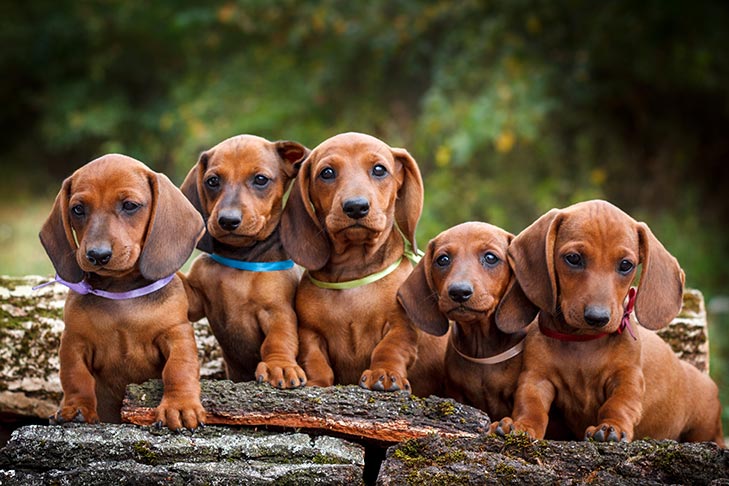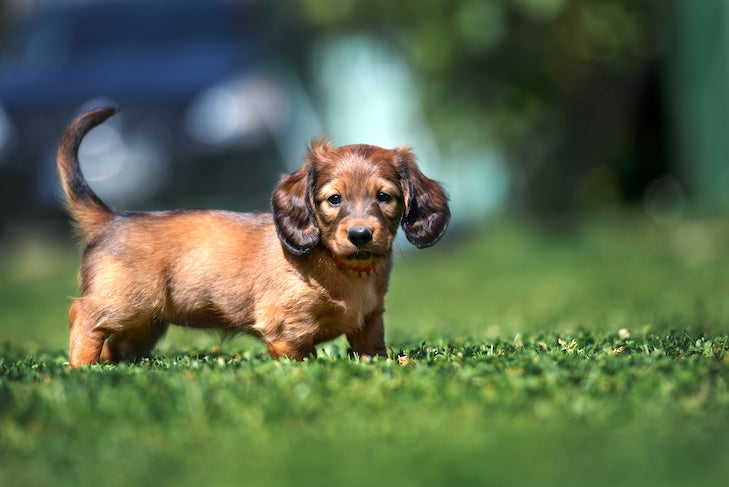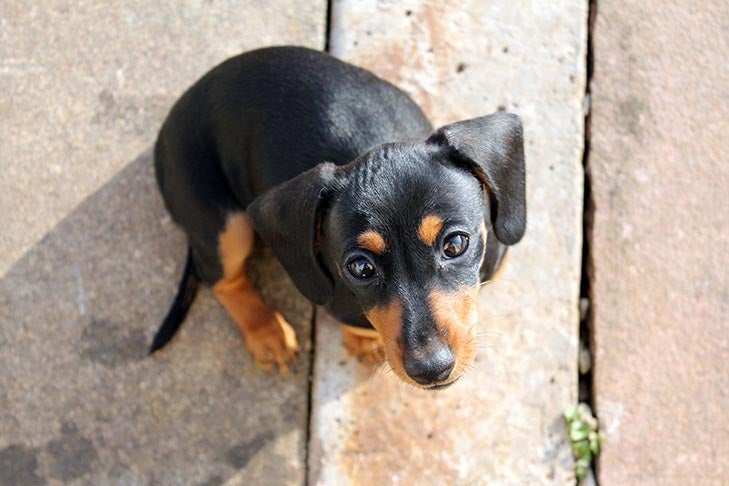Long on looks and short on training time, Dachshund puppies are fast learners. This determined and highly intelligent hound will follow your instructions, especially if you motivate them to follow your direction, and positive lessons speed the process.
Walter Jones, First Vice President of the Dachshund Club of America, remembers George, his family’s first Smooth Dachshund when he was a youngster. As an adult, Jones couldn’t wait to acquire Sebastian, his own Smooth Doxie.
“He was loyal, loving, and devoted,” says Jones, an AKC Dachshund Breeder of Merit, who went on to breed 60 Longhaired litters.
When Jones sends puppies home at 8 to 9 weeks, he recommends that his new owners begin training basic lessons right away. Establishing training goals at specific times in a Dachshund’s development leads to success.
In two sizes—Standard and Miniature and three coat varieties—Smooth, Wirehaired, and Longhaired, the same rules and timelines apply to all Dachshunds.

Key Milestones: Birth-7 Weeks
Dachshund school starts early under the breeder’s guidance. Here’s how a responsible breeder preps puppies for early training.
Training Goal #1: The Breeder’s Early Socialization
To start on the right paw, newborn pups require plenty of handling from the minute they enter this world. Breeders pick them up and weigh them daily to ensure they are gaining weight and hold them if they need supplemental bottle feeding. When the breeder cleans the whelping pen, the pups go into a crate.
“At 2 to 3 weeks, I handle the pups’ feet and begin clipping toenails,” says Deneice Van Hook DVM, Board Member and Companion Events Chair of the Dachshund Club of America. “At 3 weeks, I blow a whistle when I feed them, so they associate coming to me with getting something wonderful.”
Three weeks to 12 weeks marks the critical socialization period for puppies. Crucial for a dog’s development, puppies need to interact with littermates, people, different sounds, and experiences.
Around 6 weeks, the pups are ready to receive well-behaved children and adults. To avoid visitors bringing in viruses like Parvo, the breeder should ask visitors to remove their shoes and spray their hands with sanitizer.
“I expose the puppies to a variety of surfaces to walk on,” says Van Hook, who also teaches obedience. “Doxies are bred to hunt underground, so I give them an agility tunnel to build their confidence.”
Both Jones and Van Hook begin basic housetraining, so pups become accustomed to eliminating in a certain area, away from where they sleep.

Key Milestones: 8-12 Weeks
Your puppy comes home. Let the training begin.
Training Goal #2: Housetraining, Crate Training, and Handling
“Start housetraining on the first day,” says Jones. “Maintain a regular schedule and praise a lot.”
Choose a designated potty area for your Doxie and take your pup to the same spot each time.
Some Doxies think they should be able to relieve themselves wherever they choose, but it’s your job to convince them otherwise in a positive way. Here’s where patience comes in handy, but eventually, even the most strong-willed long and low dog will go to the appropriate spot.
“Your pup should sleep in a crate the first night and continue handling your pup every day,” says Van Hook. “Never do so in a harsh manner.”
Training Goal #3: Choose Your Goals
In addition to house and crate training, what behaviors do you want your Doxie to adopt in the coming months?
“Along with house and crate training, teaching your Doxie to come to you promptly when called takes top priority,” says Van Hook. “They’re hunting dogs, and when they see a squirrel or rabbit, they forget you exist.”
Training Goal #4: Puppy Kindergarten
Van Hook doesn’t recommend puppies going to dog parks or playing with other pups until fully immunized with two sets of core vaccines.
At 9 weeks and vaccines, puppies can attend Puppy Kindergarten classes or the AKC S.T.A.R. Puppy Program. To visit new places, meet new people, and hear different sounds, a pup can ride in a puppy stroller.
Training Goal #5: Avoiding Annoying Habits
Many owners dream of a dog who walks politely on a leash, doesn’t jump on people or furniture, resists begging at the table, and refrains from barking or rushing the door when guests arrive. Doxies can learn these behaviors.
“They really want to please you, so it helps if they understand your expectations,” says Van Hook.

Key Milestones: 3-4 Months
Dachshunds soak up whatever you teach them.
Training Goal #6: Getting the Groom On
Continue your breeder’s bathing, brushing, nail trimming, ear cleaning, and oral care routines.
Training Goal #7: Teach Basic Behaviors
Doxie pups have short attention spans so limit your sessions to five minutes. Begin with teaching:
Key Milestones: 5-9 Months
Despite its near-grown-up appearance, your Doxie is still a puppy and needs supervision.
Training Goal #8: Teach Appropriate Digging
It’s natural for a Doxie to search underground for hidden treasures, but if you take pride in a manicured lawn, designate a separate area to excavate.
Training Goal #9: Encourage Positive Behavior
Because some Doxies are prone to developing intervertebral disc disease (IVDD), or slipped disc disease, restrict your dog from jumping off furniture.
Van Hook says it’s OK for Dachshunds to compete in agility at 18 months but keep the jumps low.
“This little hound can have a mind of its own and do what it wants,” says Van Hook. “At other times, a Doxie will cuddle next to you on the sofa and look up at you with those big brown eyes, and you melt.”

